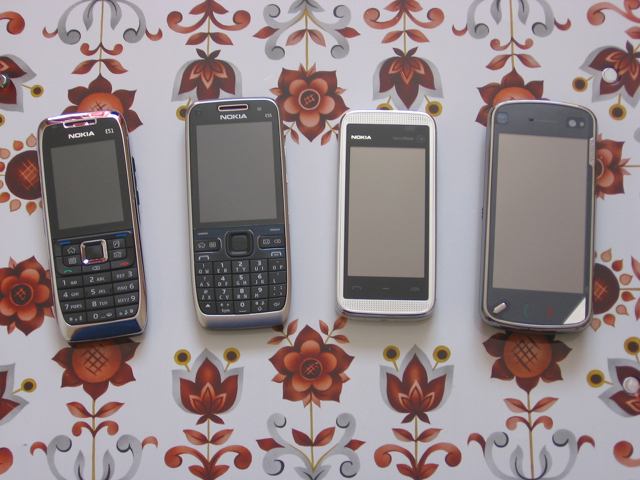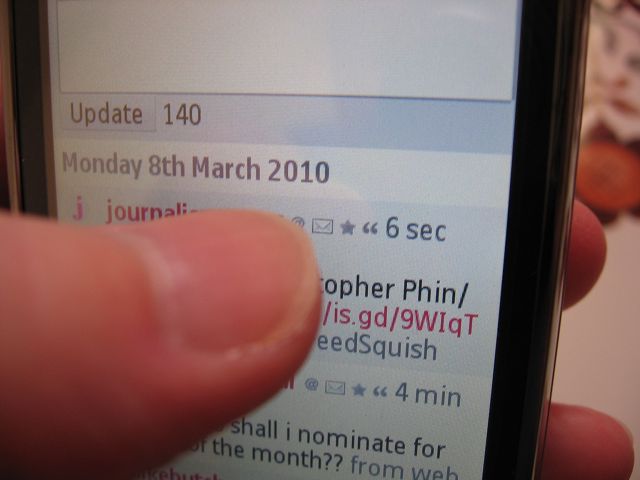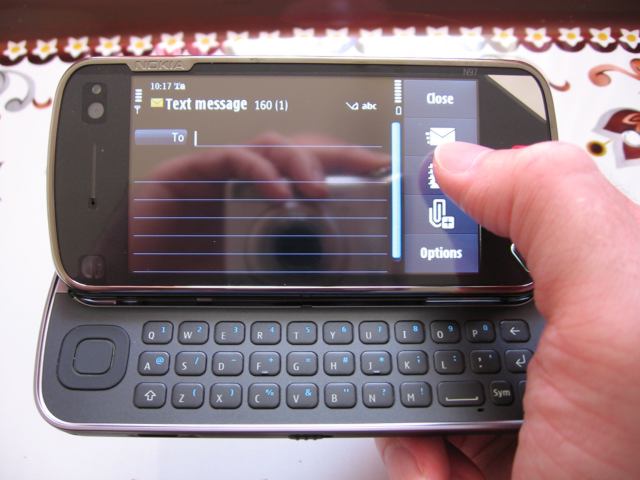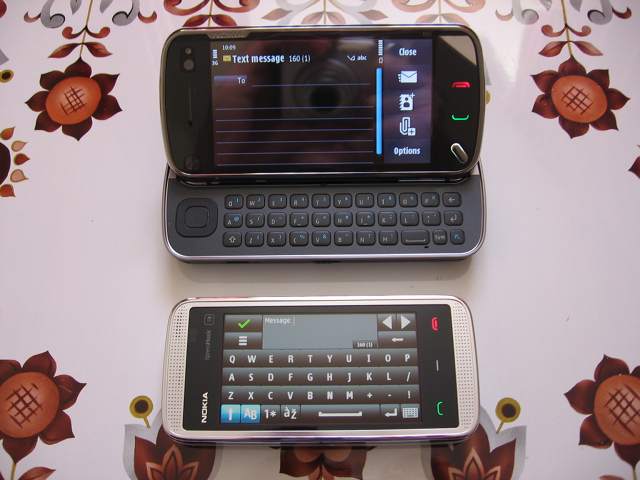For two reasons, I've been a sceptic of the touch screen renaissance:
- The first was apathy because I'd been there, done that with the Psion Series 5 and two Palm PDA's. As you'll know, these were primarily stylus driven interfaces, even though the Psion touch interface had more of a finger-friendly 'chunky' UI approach which is still evident in S60 5th Edition, and I'll return to this later. Of course, the idea of writing on, and controlling, an electronic device with something like a pen felt very futuristic. It was worth using just for the buzz that only a sci-fi loving nerd can know. However, time wore on, and the age of the PDA came to an end. It didn't take long to realise that Palm's stylus driven interface was no faster, either for text input or general use, than a D-pad driven smartphone interface. This all led me to the conclusion that touch screens had turned out to be a novelty, and were by no means any more useful than old fashioned buttons.
- My second reason was that I don't like trends; I believe that if something is at the point of setting a trend, then it's already time to find something new. So, you can imagine my reaction when I saw every mobile phone company on the planet seemingly lose their identity, in what I can only describe as mass hysteria; all because Apple made a new product. In short, I wanted no part of what I saw as 'en masse' folly.
By the time I started buying smartphones, I predictably stuck with Nokia's Eseries. This was fine if I was going to remain a private consumer, but not if I was going to start writing publicly about the mobile scene. Hence, I borrowed (thanks Rafe, Steve and Nokia PR) two Nokia S60 5th Edition phones: a 5530 for the touch-only experience, and an N97 classic to experience a hybrid design.
From left to right: E51, E55, 5530, N97
The Hardware
The first thing that I appreciated from these new phones was the increased screen size. Even the 2.9" 5530 screen was a treat to me after the QVGA 2.0''-2.4'' Eseries screens. This naturally lends itself to web browsing in landscape mode, which accounts for the bulk of reading these devices will no-doubt be used for.
The next part of my touch experience was the horror of fingerprints. Perhaps I have a mild form of OCD, but seeing any phone screen daubed in finger prints always gives me a knot in my stomach. You may say this is a subjective matter, but there is an objective problem here. I found in my experience, and I don't think I'm alone, that those oily deposits can often cause a distortion on the screen, and require you to wipe the screen with your hand. My experience of this was much worse on the 5530 than on the N97. The 5530's screen came uncovered, and was relatively glossy. Hence, fingerprints stood out like the proverbial sore thumb! However, the N97 came with the original screen protector still attached; and knowing that I'd soon be soon returning it, I decided leave the screen protector on. The protector was matte and textured, which effectively mitigated the effect of fingerprints. It still needed wiping from time to time, but it was well within my tolerance; the only problem was that it degraded the quality of the screen. Even so, perhaps matte screens are the answer for keeping fingerprints at bay?
The User Interface
When it comes to the user interface, I do recognise the feeling of freedom one gets from just being able to place a finger on the screen to make something happen. I've even found myself performing kinetic scrolling just for fun! Although, even after weeks of constant touch screen use, I am still not convinced that using touch as the exclusive method of interaction is best.
It is all too easy to block your view while trying to press a region of the screen. I could see this as a problem long before I used a touch screen phone, and I was proved right. This is particularly evident while web browsing (in either Web or Opera), and trying to tap on a tiny hyperlink (e.g. the reply & retweet icons in Dabr). I find myself resorting to measures like peering around the side of my finger to see where I'm touching, and performing nail tap 'scans' until I see the link is selected. Of course, iPhone users would boast they could pinch-zoom into such links [doesn't always work anyway - Ed], and others would say I should use a stylus. Even then, after zooming in, you'd need to zoom out again, and the stylus needs to be drawn and then stowed away. Neither are as simple as switching to a D-pad controlled cursor, and you have far more precision than you would have with a finger tip too.
Having touch elements in the same areas of the screen which have to deliver information to you is just a bad idea. Which takes me back to the Psion-style touch interface. I think that Symbian has it right by displaying large touch buttons down the side, or bottom, of the screen. They are easy to press, their function is clear, and they don't get in the way of what you're looking at.
For text input, the portrait-mode virtual T9 keypad is fine for tapping off a brief single-handed text message. Alas, this is only adequate for the shortest of text messages, because while it's a nice experience, it is slow. Moving beyond portrait mode input, let's look at the landscape options; i.e. the full-screen qwerty keyboard on touch-only phones and the physical keyboard of hybrid models. I was surprised at how quickly I could type on the full-screen 5530 keyboard, but its main problem was that the keyboard took up so much space - there's very little room remaining to review what you are typing.
The physical keyboard has to win out here because of the tactile feedback. Haptic feedback is good, but it only signals that a touch was registered, which doesn't help you to find the right button without looking. However, of the two phones, there were mitigating factors that almost put the N97 classic and 5530 on even terms. Thanks to the 5530's smaller 2.9'' screen, my thumbs never had to stretch to reach anything, unlike on the N97. Although, most significantly, the N97 keyboard has some unfortunate choices about key placement, namely having the space bar on the right-hand side, and the shift key on the same side as the D-pad. However, I would rather have these strangely placed keys if it meant having the whole screen to actually see what I'm typing! Thus, I think it's reasonable to assume that a well laid out physical keyboard would clearly win out over a touch screen keyboard every time.
Conclusion
Looking over my experiences with touch screens, I can certainly say my scepticism has eased, and I can live with them. However, I think by far the biggest advantage I've enjoyed from touch screen phones isn't the touch aspect at all - it's the screen size [agreed 100% - Ed]. Touch control just gives an added convenience factor. Although, I think common sense has to be used more in touch interfaces, such as not requiring touches that are going to block the view of the rest of the screen.
Touch screens have yet to win me over completely. If I see a phone which only has a touch interface, I still won't see the pinnacle of post-modern consumer electronic design; I will see a device that's missing a keyboard. Having a keyboard gives you the tactile feedback and precision that a flat touch screen never will.
David Gilson, All About Symbian, 9 Mar 2010




